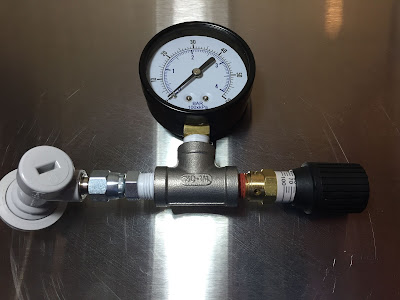"A Spunding valve allows you to maintain a set pressure. If pressure in the pressure vessel exceeds the set point, it is expelled.
About Carbonating with a Spunding valve. Carbonation directly in your keg allows you to naturally carbonate your beer (saving CO2 and $) while maintaining reasonably tight control on carbonation levels. This could be done by adding priming sugar, capping fermentation prior to the completion of fermentation or more traditional krausening (adding wort back to the fermenter) methods.
Basic Steps for Carbonating in a Keg Using a Spunding Valve:
- Prime the keg with your choice of priming sugar or wort (or start this process late in fermentation when some fermentable sugars remain)
- Determine your desired pressure based on temperature and desired carbonation using a carbonation chart. See: Balancing Your Draft System for a carbonation chart.
- Pressurize the keg to just over your desired final pressure.
- Attach the Spunding Valve
- Dial down the pressure until you achieve your desired pressure
- Wait. As the remaining simple sugars are fermented, carbonation occurs and excess CO2 will be expelled from the spunding valve giving you just the right amount of carbonation. I give it a couple days after reaching target pressure. If you’re less sure how much fermentable sugar remained, I would suggest giving it a few days longer.
- Chill your keg, allowing your beer to absorb head space CO2 and reach equilibrium."
You will need the control valve below:
Directions to build a Spunding Valve can found here from Home Brew Finds.


No comments:
Post a Comment